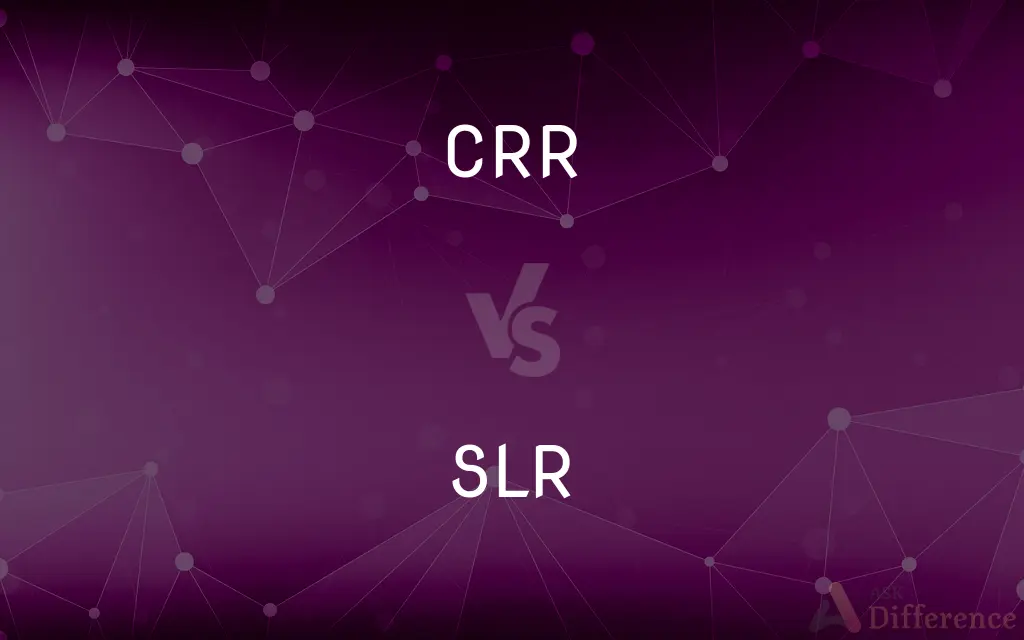CRR vs. SLR — What's the Difference?
By Tayyaba Rehman — Published on January 3, 2024
CRR refers to the Cash Reserve Ratio, while SLR stands for Statutory Liquidity Ratio

Difference Between CRR and SLR
Table of Contents
ADVERTISEMENT
Key Differences
CRR, or Cash Reserve Ratio, is the percentage of total deposits that banks are required to maintain with the central bank in the form of cash. SLR, or Statutory Liquidity Ratio, dictates the percentage of deposits banks must hold in liquid assets.
With CRR, the main objective is to control the money supply in the economy, ensuring banks don't run out of cash to meet immediate withdrawal demands. Conversely, SLR seeks to ensure that banks maintain sufficient liquid assets to meet unforeseen contingencies.
CRR emphasizes maintaining cash reserves, directly impacting the amount of funds banks can lend. On the other hand, SLR involves holding both cash and other assets such as government securities, ensuring banks have enough assets they can quickly convert to cash.
While CRR directly affects the lending power of banks, SLR indirectly ensures banks have a safety buffer. When the central bank adjusts CRR and SLR, it impacts credit creation, liquidity in the system, and the overall economic stability.
In the grand scope of financial stability, both CRR and SLR play vital roles. CRR serves as a direct tool for monetary control, whereas SLR provides an indirect buffer, supporting banks during financial distress.
ADVERTISEMENT
Comparison Chart
Nature
Cash reserves with central bank.
Liquid assets including cash.
Purpose
Control money supply.
Ensure bank's liquidity.
Components
Only cash.
Cash, gold, government securities.
Effect on Lending
Directly impacts.
Indirectly impacts.
Regulatory Focus
Monetary control.
Financial stability buffer.
Compare with Definitions
CRR
CRR ensures banks don't run out of cash for immediate demands.
Maintaining the required CRR is crucial for a bank's daily operations.
SLR
SLR can indirectly influence the amount banks lend.
When SLR requirements rise, banks might have less money available for lending.
CRR
CRR is the Cash Reserve Ratio that banks must maintain.
Banks adjust their lending rates based on the CRR set by the central bank.
SLR
SLR acts as a safety net for banks against unforeseen financial challenges.
Having a higher SLR can make a bank more resilient during economic downturns.
CRR
CRR represents a bank's cash reserve obligations.
The central bank can modify CRR to control liquidity in the market.
SLR
SLR stands for Statutory Liquidity Ratio.
A bank's SLR indicates its financial health in terms of liquid assets.
CRR
CRR determines the cash percentage banks hold with the central bank.
A higher CRR means banks have less money for loans.
SLR
SLR serves as a regulatory requirement for banks.
Not maintaining the required SLR can lead to penalties for the bank.
CRR
CRR acts as a monetary policy tool.
Changes in CRR can influence a country's economic direction.
SLR
SLR is the ratio of liquid assets to demand and time liabilities.
The bank maintains its SLR in cash, gold, and government securities.
Common Curiosities
What is the difference between CRR and SLR?
CRR is cash held with the central bank, while SLR includes cash, gold, and government securities.
What does CRR stand for?
CRR stands for Cash Reserve Ratio.
Can the central bank change the CRR?
Yes, the central bank can modify CRR as a monetary policy tool.
How does SLR differ in composition compared to CRR?
While CRR consists only of cash, SLR can include cash, gold, and government securities.
How does CRR influence a bank's lending capacity?
A higher CRR means banks have less money available for loans.
Why is SLR essential for banks?
SLR ensures banks maintain sufficient liquid assets to face unforeseen financial challenges.
How can SLR affect the lending practices of a bank?
A higher SLR can limit the amount a bank has available for lending.
How do CRR and SLR impact a country's economy?
They influence liquidity, lending practices, and overall financial stability in the economy.
Why is CRR important for banks?
CRR ensures banks have enough cash on hand to meet immediate withdrawal demands.
What does SLR stand for?
SLR stands for Statutory Liquidity Ratio.
Which is more liquid, assets under CRR or SLR?
CRR assets are more liquid as they consist only of cash.
How often are banks required to maintain CRR and SLR?
Typically, banks are required to maintain these ratios daily or weekly, depending on the central bank's regulations.
Do CRR and SLR only apply to large banks?
No, they generally apply to all scheduled commercial banks in the jurisdiction.
Can a bank face penalties for not maintaining the required CRR and SLR?
Yes, banks can face penalties for not adhering to the mandated CRR and SLR.
Is SLR a global standard?
While SLR-like requirements exist globally, specific ratios and regulations can vary by country.
Share Your Discovery

Previous Comparison
Altruism vs. Selflessness
Next Comparison
Bhakti Movements vs. Sufi MovementsAuthor Spotlight
Written by
Tayyaba RehmanTayyaba Rehman is a distinguished writer, currently serving as a primary contributor to askdifference.com. As a researcher in semantics and etymology, Tayyaba's passion for the complexity of languages and their distinctions has found a perfect home on the platform. Tayyaba delves into the intricacies of language, distinguishing between commonly confused words and phrases, thereby providing clarity for readers worldwide.














































